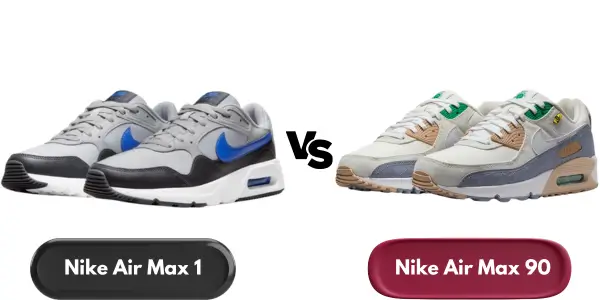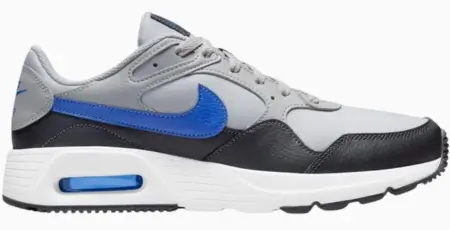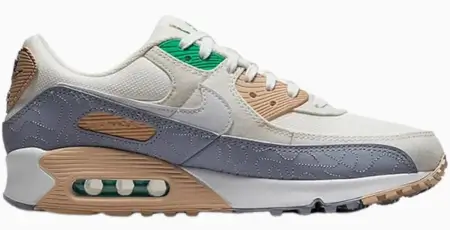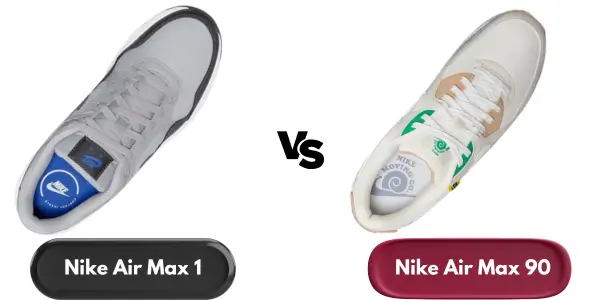Nike Air Max 1 vs Air Max 90 Comparison
Last Updated: January 01, 2025 | Author: Jake Thompson
In the sneaker world, choosing between the Nike Air Max 1 vs Air Max 90 is a major debate, similar to deciding between the sun and the moon.
Delving into their differences reveals Air Max 1 as a symbol of Nike's innovation, thanks to its visible air unit. The Air Max 90, however, elevates the game with a bolder design and enhanced cushioning.

As someone deeply immersed in sneaker culture, I find their differences in materials, design, and cultural impact fascinating. This isn't just about preference; it's about understanding the unique appeal of each model and how it influences personal style and performance.
Join me in exploring what sets each sneaker apart, and maybe you'll discover which one truly matches your stride.
Table of Contents:
- Key Takeaways
- Pros & Cons
- Performance and Functionality
- Material and Quality
- Design Elements
- Exterior Design
- Sole Design
- Comfort and Fit
- Durability Considerations
- Final Verdict
- Frequently Asked Questions
Key Takeaways
- - The Air Max 1 and Air Max 90 are both iconic sneakers in Nike's Air Max line, with the Air Max 1 debuting in 1987 and the Air Max 90 in 1990.
- - The Air Max 90 is generally slightly cheaper than the Air Max 1, making it a more budget-friendly option for sneaker enthusiasts.
- - The Air Max 90 offers a wider variety of colorways compared to the Air Max 1, with options like Industrial Blue and Anthracite Mystic Red being popular choices.
- - When deciding between the Air Max 1 and Air Max 90, personal preference plays a crucial role, and trying both models in-store can help determine the best fit.
Table: Air Max 1 Vs Air Max 90

|

|
|
|---|---|---|
| Feature | Nike Air Max 1 | Nike Air Max 90 |
| Cushioning | Visible Air unit in the heel | Larger visible Air unit in the heel, enhanced cushioning around the ankle |
| Upper | Mesh and suede/nubuck, depending on the colorway | Mesh, suede, and synthetic leather, more overlays for durability |
| Outsole | Waffle pattern for traction | Modified waffle pattern for improved traction |
| Midsole | Polyurethane midsole for stability and cushioning | Foam midsole for cushioning includes a visible Air-Sole unit |
| Intended Use | Running and casual wear | Running and casual wear, with a focus on increased comfort and durability |
| Design | Minimalist with a focus on showcasing the Air unit | Bulkier silhouette with more aggressive design elements |
| Technology | First model to feature Nike’s Air technology in a visible unit | Built on the success of the Air Max 1, adding more cushioning and support |
| Iconic Colorways | University Red, Royal Blue | Infrared, Laser Blue, Volt |
| Price |
Pros & Cons
Air Max 1
Pros:- - Affordable
- - Waterproof construction.
- - Comfortable with good traction on various terrains.
- - Heavier and less breathable.
- - Less flexible compared to newer models.
Air Max 90
Pros:- - Improved breathability
- - Lightweight design.
- - Enhanced comfort and support with better traction.
- - Higher price point.
- - Less protective than the Moab 2's suede construction.
Performance and Functionality
Regarding performance and functionality, both Nike shoes offer distinct features that cater to different preferences. The Air Max 1 is generally lighter and more suited for running, with a sleek fit and a less bulky midsole, allowing for a more natural foot movement. Its air unit, visible through the cutout in the heel, revolutionized sneaker technology, bringing lightweight comfort ideal for runners seeking a responsive feel.
On the flip side, the Air Max 90's design includes a thicker midsole and a larger air unit, translating into superior cushioning. This robust enhancement in the heel absorbs impact more efficiently, making the Air Max 90 a comfortable choice for all-day wear and diverse physical endeavors. The fit of the Air Max 90 is also noteworthy; it's roomier, accommodating a wider range of foot shapes without sacrificing support.
Material and Quality
While evaluating the performance aspects of Nike Air Max 1 vs Air Max 90, it's equally crucial to scrutinize the material quality that contributes to their durability and overall wear experience. Diving into the details, I've noticed that the Air Max 1 often features a breathable mesh upper, which not only offers comfort but also ensures durability. On the flip side, the Air Max 90 steps up the game with its black leather panels, providing a robust framework that enhances the shoe's structure.
The mudguard, a defining feature of the Air Max 90, presents a noticeable difference in material quality. This addition not only serves a functional purpose but also contributes to the shoe's longevity. To make this comparison more relatable, here's a breakdown of the materials used in each model:
| Feature | Air Max 1 | Air Max 90 |
|---|---|---|
| Upper Material | Breathable mesh | Mesh with black leather panels |
| Mudguard | Absent | Leather with quality stitching |
| Overall Feel | Light and flexible | Sturdy with a premium touch |
Both sneakers offer a unique combination of materials that cater to different preferences. Whether you prioritize flexibility or durability, the choice between mesh and leather, along with the construction quality, will ultimately guide your decision.
Design Elements
When we scrutinize the exterior design, it's evident that each silhouette broadcasts a distinctive aesthetic language.
The Air Max 1's minimalistic approach with its sleek lines contrasts sharply with the Air Max 90's bolder, more aggressive stance, marked by its chunkier profile and the addition of leather panels for structural reinforcement.
Analyzing the sole design, I appreciate how the Air Max 90's larger Air bubble isn't just an iconic visual element, but also amplifies the cushioning, a testament to Nike's commitment to melding form with function.
Exterior Design
Turning our attention to exterior design, it's evident that both Nike shoes showcase distinct design elements that cater to different aesthetic preferences and functional needs.
The Air Max 1, designed by Tinker Hatfield, set the stage with its visible Air unit—a first for Nike—incorporated into a sleek, low-profile sneaker. The Nike logo is tastefully placed, complementing the overall minimalist approach.
In contrast, the Air Max 90's profile is markedly bolder, featuring a popping mudguard on the side that adds a dynamic edge. This sneaker's exterior design is more complex, with additional layers and textures, including the iconic black leather panels.
Both designs have stood the test of time, underpinning the versatility and enduring legacy of Hatfield's vision.
Related: Nike Dunks and Air Force 1s
Sole Design
Delving into the sole design, it's clear that the Air Max 1 and Air Max 90 differ significantly in their outsole patterns and structural elements, reflecting their tailored approach to both aesthetic appeal and functional performance.
The Air Max 1 features a classic pattern with strategically placed grooves that optimize grip, while the smooth midsole houses the iconic air cushioning, a testament to Nike's innovative spirit.
In contrast, the Air Max 90's sole design is more layered, with an additional panel that not only adds a pop of color but also enhances the structural integrity of the outsole. This design ensures a robust grip, complemented by the larger air cushioning unit that offers superior comfort.
Each model's sole pattern is meticulously crafted to provide a distinct walking experience.
Comfort and Fit
Assessing the comfort and fit, it's clear that each model's design nuances significantly impact the wearer's experience.
The Air Max 1, with its original silhouette, offers a relatively snug fit, often requiring a break-in period to achieve optimal comfort. This model tends to be true to size, providing a form-fitting embrace that seasoned sneaker enthusiasts might prefer.

On the flip side, the Air Max 90 is known for its wider toe box, which can be a boon for those with broader feet. The cushioning is also a point of distinction; the larger air bubble in the Air Max 90's heel not only enhances the visual appeal but contributes to a more comfortable walking experience. The padding in the Air Max 90 feels sufficient without being overly plush, striking a balance between support and coziness.
Both models boast a cushioned midsole, but the Air Max 90's additional volume in the air unit means it's often perceived as the more comfortable option right out of the box. The choice, then, comes down to personal preference: the sleeker, break-in-required contour of the Air Max 1 or the ready-to-wear, cushier feel of the Air Max 90.
Related: Adidas vs Nike Running Shoes
Durability Considerations
While considering comfort and fit is crucial, it's equally important to examine their durability, as this determines the longevity of the sneakers under regular wear and tear. When I'm picking out Nike sneakers, I'm not just looking at aesthetics; I'm scrutinizing how well they'll hold up over time. Here's my breakdown:
- Materials: Both models employ robust materials, but the Air Max 90 often features additional leather overlays that can provide extra resilience against scuffs and stains compared to the Air Max 1's lighter mesh and suede construction.
- Outsole Wear: The tread patterns on both are designed for grip and durability. However, the Air Max 90's thicker sole might offer slightly better longevity when faced with abrasive surfaces.
- Air Unit Integrity: The larger visible air bubble in the Air Max 90 may be more susceptible to wear over time. But Nike's air units are notoriously sturdy, so the difference might be minimal.
- Upper Durability: The Air Max 1's mesh upper, while comfortable, can show wear quicker than the tougher synthetic or leather panels of the Air Max 90.
In the air max 1 vs air max 90 debate, both stand out for their durability, but the choice hinges on the type of use and personal preference for either model's unique construction.
Final Verdict
When comparing the Air Max 1 and Air Max 90, it's clear that each sneaker has its unique strengths and appeals. The Air Max 1 is celebrated for its revolutionary design and lightweight feel, making it a favorite for those who appreciate minimalist style and historical significance. On the other hand, the Air Max 90 is known for its enhanced cushioning, durability, and bolder design, catering to those seeking comfort and a more pronounced look. Ultimately, the choice between the two depends on personal preference, as both offer distinctive qualities that resonate with different aspects of sneaker culture and individual style.
Discover more about Nike's outdoor basketball shoes to see how they stand up on the court.
Frequently Asked Questions
1. What are the main differences between Air Max 1 and Air Max 90?
The Air Max 1 introduced Nike's Air technology in a visible unit on the side of the shoe, offering excellent cushioning. The Air Max 90, also featuring this technology, is centimeters higher, providing more support and a bolder aesthetic with its infrared colors.
2. Which of the two sneakers, Air Max 1 or Air Max 90, is generally more expensive?
Although the retail price can vary depending on collaboration and edition, the Air Max 90 is often slightly more expensive due to its more complex design and additional features.
3. Can you find the Air Max 1 and Air Max 90 in the same color schemes?
Yes, both pairs of Air Max sneakers are available in a variety of color schemes, including the iconic infrared colors. Nike frequently releases both models in matching or similar colorways to cater to fans of each style.
4. Is there a difference in weight between the Air Max 1 and Air Max 90?
Yes, the Air Max 90 is a heavier shoe compared to the Air Max 1. This is due to its additional cushioning and more robust design, which also features a slightly taller silhouette.
Share this:







